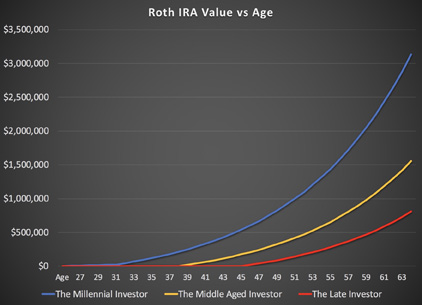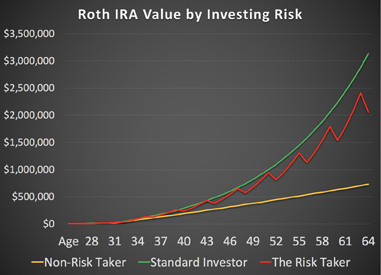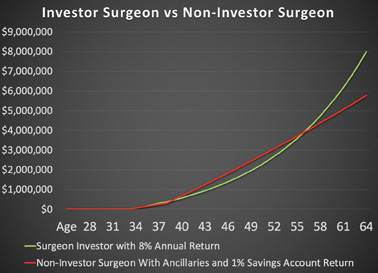Compound interest: A powerful ancillary revenue stream
Click Here to Manage Email Alerts


by Sanjeev Bhatia, MD, and David B. Mandell, JD, MBA
With health care continuously in flux, physicians of all specialties have often wondered how to maintain their income and achieve financial goals while avoiding burnout. Although ancillary revenue streams have decreased and overhead costs have increased over the years, the single most powerful wealth creator in human history has remained constant: Compound interest.
Physicians too often focus on practice-related revenue streams as a sole means for building wealth without realizing the comparative might of a compounding asset class. In some cases, this leads to significant stress. By not harnessing the power of compound interest, your financial goals will remain handcuffed to your ever-changing practice environment.
Here, we illustrate the magnificent power of compound interest and demonstrate why cultivating this should be your principal focus for wealth creation, especially for younger physicians and residents.
Power of compound interest
Albert Einstein once noted that the most powerful force in the universe was that of compounding. Much like a snowball that grows in size as it rolls down a mountain, a compounding asset gains steam with each passing year as you begin to earn interest income on your interest income. The result is wealth that grows at an ever-accelerating rate.
In simple terms, three factors determine how your money will compound: the interest rate you earn on your investments (rate of return), the time horizon and your tax rate. As discussed in previous articles, tax-advantaged vehicles like Roth IRAs, traditional IRAs, 401(k) plans, cash value life insurance, and 529 college savings plans may allow tax-free growth and sometimes tax-free access.
Saving early makes a difference
For young physicians and residents, investing even a small amount during their 20s and 30s helps them achieve their financial goals faster than most other things they will do during their medical careers. For example, consider the three doctors who contribute to their Roth IRAs (a tax advantaged retirement vehicle) at different stages of life. Each earns the same 8% annual return on their Roth IRA.

The millennial investor contributes $200 per month to his Roth IRA starting at age 26 and then contributes $1,500 per month starting at age 33 when he lands his first job. The middle-aged investor doesn’t contribute anything to her Roth IRA until she turns 40, after which she contributes $1,500 per month until retirement at age 65. Finally, the late investor contributes $1,500 per month to his Roth IRA starting at age 47. By age 65, due to compounding, the millennial investor has amassed $3,130,451 in his Roth IRA while the others are far behind.
Slow and steady wins the race
The interest rate, or rate of return, is one of the most important determinants in the value of an asset at maturity. Although a high interest rate is always beneficial to wealth creation, it is important to avoid excess risk while optimizing interest rates to minimize devastating losses. One reason the stock market has purportedly been hailed as the greatest wealth generator in the U.S. is that historically the Standard & Poor's (S&P) 500 index, which is a reasonable risk profile asset class, has returned an inflation-adjusted 7% to 8% annual return.
In this second example, consider three investors who all contribute the same amount to their Roth IRA over a 30-year period. The first investor, the non-risk taker, does not care to get anything beyond a 1% rate. The standard investor follows the S&P 500 index and gets an 8% annual return. Finally, the risk taker gets a staggering 15% annual return by investing in high growth stocks and private investments, but sees his portfolio decline by 15% every 4 years due to cyclical downturns in the markets.

As you can see, the standard investor comes out far ahead of the other two due to continued growth and avoidance of devasting losses.
Your best ancillary revenue stream: Simple investing
Finally, it should be noted that simple investing, begun prudently at an early age, may even trounce many lucrative practice-related ancillary revenue streams due to tax advantages and the power of compounding.

Starting at age 35, the investor surgeon starts contributing $5,000 per month to an S&P 500 index fund yielding an 8% return annually and does this until age 65. In contrast, the non-investor surgeon chooses to put away $5,000 per month beginning at age 35 in a savings account that yields only 1% annually. At age 40, however, he chooses to become part owner in a lucrative ancillary revenue stream that pays an additional $10,000 per month after taxes until his retirement at age 65. This additional revenue is also deposited in the savings account. Interestingly, despite missing out on the lucrative ancillary opportunity and a more basic resultant income, the investor surgeon has $2,224,662 more than his counterpart at age 65 due to the power of compound interest.
Conclusions
Physicians too often focus on practice-related revenue streams as a sole means for building wealth and do not realize the comparative strength of a compounding asset class.
As shown in these examples, the impressive power of compound interest is the greatest tool for wealth creation, especially for younger physicians and residents who start investing at an early age.
- Reference:
- For Doctors Only or Wealth Management Made Simple are available free in print or by e-book download by texting HEALIO to 555-888 or at www.ojmbookstore.com. Enter code HEALIO at checkout.
- For more information:
- Sanjeev Bhatia, MD, is an orthopedic sports medicine surgeon at Northwestern Medicine in Warrenville, Ill. He can be reached at: sanjeevbhatia1@gmail.com.
- David B. Mandell, JD, MBA, is an attorney and founder of the wealth management firm OJM Group. Seek professional tax and legal advice before implementing any strategy discussed herein. Mandell can be reached at: mandell@ojmgroup.com or 877-656-4362.
Disclosures: Bhatia and Mandell report no relevant financial disclosures.

